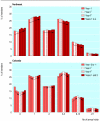Effect of electronic health records in ambulatory care: retrospective, serial, cross sectional study
- PMID: 15760999
- PMCID: PMC554034
- DOI: 10.1136/bmj.330.7491.581
Effect of electronic health records in ambulatory care: retrospective, serial, cross sectional study
Abstract
Objective: To evaluate the effect of implementing comprehensive, integrated electronic health record systems on use and quality of ambulatory care
Design: Retrospective, serial, cross sectional study.
Setting: Colorado and Northwest regions of Kaiser Permanente, a US integrated healthcare delivery system.
Population: 367,795 members in the Colorado region and 449,728 members in the Northwest region.
Intervention: Implementation of electronic health record systems.
Main outcome measures: Total number of office visits and use of primary care, specialty care, clinical laboratory, radiology services, and telephone contact. Health Plan Employer Data and Information Set to assess quality.
Results: Two years after electronic health records were fully implemented, age adjusted rates of office visits fell by 9% in both regions. Age adjusted primary care visits decreased by 11% in both regions and specialty care visits decreased by 5% in Colorado and 6% in the Northwest. All these decreases were significant (P < 0.0001). The percentage of members making > or = 3 visits a year decreased by 10% in Colorado and 11% in the Northwest, and the percentage of members with < or = 2 visits a year increased. In the Northwest, scheduled telephone contact increased from a baseline of 1.26 per member per year to 2.09 after two years. Use of clinical laboratory and radiology services did not change conclusively. Intermediate measures of quality of health care remained unchanged or improved slightly.
Conclusions: Readily available, comprehensive, integrated clinical information reduced use of ambulatory care while maintaining quality and allowed doctors to replace some office visits with telephone contacts. Shifting patterns of use suggest reduced numbers of ambulatory care visits that are inappropriate or marginally productive.
Figures


References
-
- McGlynn EA, Asch SM, Adams J, Keesey J, Hicks J, DeCristofaro A, et al. The quality of health care delivered to adults in the United States. N Engl J Med 2003;348: 2635-45. - PubMed
-
- Chassin, MR, Galvin, RW. The urgent need to improve health care quality: Institute of Medicine National Roundtable on Health Care Quality. JAMA 1998;280: 1000-5. - PubMed
-
- McNeil BJ, Hidden barriers to improvement in the quality of care. N Engl J Med 2001;345: 1612-20. - PubMed
-
- Hersh WK. Medical informatics: improving health care through information. JAMA 2002;288: 1955-8. - PubMed
Publication types
MeSH terms
LinkOut - more resources
Full Text Sources
